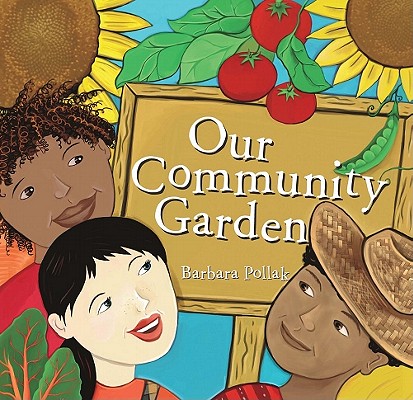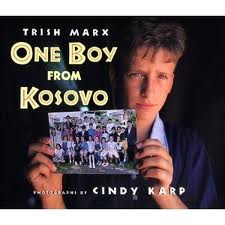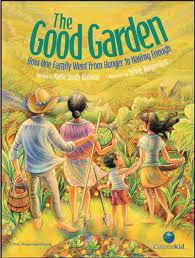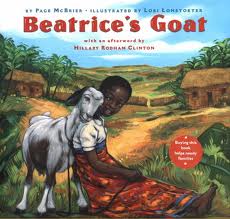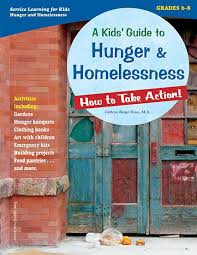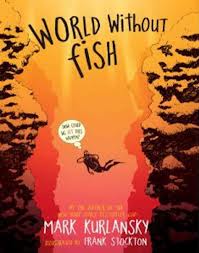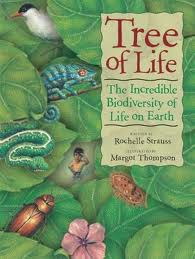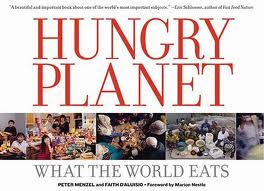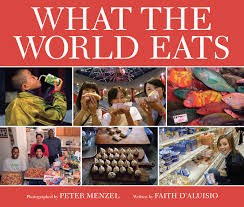Our Community Garden by Barbara PollakIf you could plant a garden that would represent your personality and heritage, what would it include? Maybe cherry tomatoes, green peppers and delicious blueberries? Audrey Aubergine and her neighbourhood friends do just that in a community garden as they play hide-and-seek amidst giant sunflowers, count ladybugs and make compost mazes. Readers will enjoy following the garden's progress and will be inspired to start one of their own. Author and illustrator Barbara Pollak's colourful illustrations highlight the children's daily adventures in the garden. At the end of the story, the children and their families gather for a potluck to celebrate their garden and enjoy the fruits of their labour.
|
One Boy from Kosovo by Trish MarxWhen war drove twelve-year-old Edi and his family from their home in Kosovo, they fled across the Macedonian border to the Brazda refugee camp, a tent city that housed almost thirty thousand people. There the family shared a tent with more than twenty other people, with no kitchen, no running water, and no school for Edi to attend. Instead he helped out with the younger kids, played soccer with the other boys, and ran errands, such as waiting in the long lines for food and fresh water. Everybody was waiting in Brazda -- for news about relatives, for the war to end, for the day when they could finally go home again.
|
The Good Garden by Katie Smith MilwayMaria Luz and her family are poor farmers who live in the hills of Honduras. Like many struggling farmers around the world, they grow barely enough food to feed themselves. When the family’s food supply runs low, Maria Luz’s father must leave to find work and she is left to tend their garden alone. Then a new teacher comes to town, and changes start to happen. The teacher shows Maria Luz how to feed the soil with compost and create terraces that stop the earth from washing away. He shows her how to grow cash crops and, even more importantly, how to bypass the predatory middleman, the coyote, and sell her produce directly at the market. And as other villagers see Maria Luz’s “good garden,” they too make changes that begin to transform their lives. New farming methods – and hope – spread through the hillsides of Honduras like a healthy vine.
The Good Garden is a simple story about a big issue: food insecurity. About 75 percent of poor farmers around the world are not food secure – they do not grow enough to feed their families and buy other necessities of life. The Good Garden is an introduction to this global issue. It also provides children with tools and information to help them make a difference, locally and globally, through the book and its interactive website: www.thegoodgarden.org. |
One Hen by Katie Smith MilwayKojo lives in a small town in Ghana, West Africa. He and his mother survive by gathering and selling firewood. There is never much money or food – just enough to get by. When Kojo is given a small loan, he has an idea. He will use the money to buy a hen, so that they will have eggs to eat. Soon there are extra eggs to sell at the market. With the profits, Kojo buys more hens and eventually earns enough for his school fees. After finishing school, he gets a bigger loan and gradually builds up a poultry farm, hires workers and pays taxes that improve his community. Along the way, Kojo loans others money so that they too can leave poverty behind.
To watch a short Youtube clip on One Hen, go here. To connect to the One Hen Website, a great interactive site filled with ideas and resources for children and teachers, go here. |
Beatrice's Goat by Page McBrierBeatrice’s Goat is a 2001 children’s story based on the true account of Beatrice Biira, an impoverished Ugandan girl whose life is transformed by the gift of a goat from the non-profit world hunger organization Heifer International. The picture book, written by Page McBrier and illustrated by Lori Lohstoeter, shows how the arrival of the goat sustains the family, and allows Beatrice to achieve her dream of attending school. In an afterword, Hillary Rodham Clinton writes, “Beatrice’s Goat” is a heart-warming reminder that families, wherever they live, can change their lives for the better.” A portion of the proceeds from the sale of the book support Heifer International.
|
Planting the Trees of Kenya by Claire A. NivolaWangari Maathai, winner of the 2004 Nobel Peace Prize and founder of the Green Belt Movement, grew up in the highlands of Kenya, where trees cloaked the hills, fish filled the streams, and the people tended their gardens. But over many years, as more and more land was cleared, Kenya was transformed. When Wangari returned home from college in America, she found the streams dry, the people malnourished, and the trees gone. How could she alone bring back the trees and restore the gardens and the people? With glowing watercolour illustrations and lyrical prose, Clare Nivola tells the remarkable story of one woman’s effort to change the fate of her land by teaching many to care for it.
|
A Kid's Guide to Hunger and Homelessness: How to Take Action! by Cathryn Berger KayeKids explore what others in the world (including young people) have done and are doing to address the issues, find out what their community needs and develop a service project. The workbook includes facts, quotations, real-life examples, write-on pages, resources, a note to adults – and lots of inspiration to get out there and make a difference in the world. Includes exclusive interviews with author and activist Francis Moor Lappe and Lindsey Lee Johnson, author of Soul Moon Soup, the story of a girl living on the streets with her mother.
About the Author Cathryn Berger Kaye is an international service learning consultant and a former classroom teacher. She works with the state departments of education, university faculty and student, school districts, and classroom teachers on a variety of education issues such as service learning, civic responsibility, student leadership, and respectful school communities. She lives in Los Angeles with her husband and two daughters. |
World Without Fish by Mark KurlanskyWritten by a masterful storyteller, World Without Fish is the alarming true story of what’s happening to fish, the oceans, and our environment. It tells how and why the fish we most commonly eat, including tuna, salmon, cod, and swordfish, could become extinct within fifty years, and the terrible domino effect this will have: oceans teeming with jellyfish and turning pinkish-orange from algal blooms; seabirds, then reptiles, then mammals disappearing. It describes the effects of overfishing and global warming, and how bottom-dragging nets turn the ocean floor into a virtual desert. But, World Without Fish is also a call to action. With its focus on supporting sustainable fishing, it shows how, from little steps to big, kids can – and must – make a difference. A world without fish? Don’t let it happen!
|
Tree of Life by Rochelle StraussTree of Life is a dazzlingly illustrated and child-friendly introduction to biodiversity – the incredible variety of life on Earth – and shows how living things are classified, or organized, into five branches. This book also reminds us that every species is important to the Tree of Life. A problem with just one branch, one twig or one leaf may affect the whole tree.
|
Hungry Planet - What the World Eats by Peter Menzel and Faith D'AluisioToday we are witnessing the greatest change in global diets since the invention of agriculture. Globalization, mass tourism, and giant agribusiness have filled American supermarket shelves with extraordinary new foods. And, in return, McDonald’s, Kentucky Fried Chicken, and Kraft Cheese Singles are being exported to every corner of the world.
In Hungry Planet, the creative team behind the best=selling Material World book, Peter Menzel and Faith D’Aluisio, presents a photographic study of families from around the world, revealing what people eat during the course of one week. Each family’s profile includes a detailed description of the weekly food purchases; photographs of the family at home, at market, and in the community; and a portrait of the entire family surrounded by a week’s worth of groceries. To assemble this remarkable comparison, Menzel and D’Aluisio travelled to twenty-four countries and visited thirty families from Bhutan and Bosnia to Mexico and Mongolia. |
What the World Eats by Peter Menzel and Faith D'AluisioTo find out how mealtime is changing in real homes, authors Peter Menzel and Faith D’Aluisio visited families around the world to observe and photograph what they eat during the course of one week. They joined parents while they shopped at mega grocery stores and outdoor markets, and participated in a feast where a single goat was shared among many families. They watched moms making dinner in kitchens and over cooking fires, and they sat down to eat with twenty-five families in twenty-one countries - if you’re keeping tract, that’s about 525 meals. As Peter and Faith ate and talked with families, they learned firsthand about food consumption around the world and its corresponding causes and effects. The resulting family portraits offer a fascinating glimpse into the cultural similarities and differences served on dinner plates around the globe.
|

